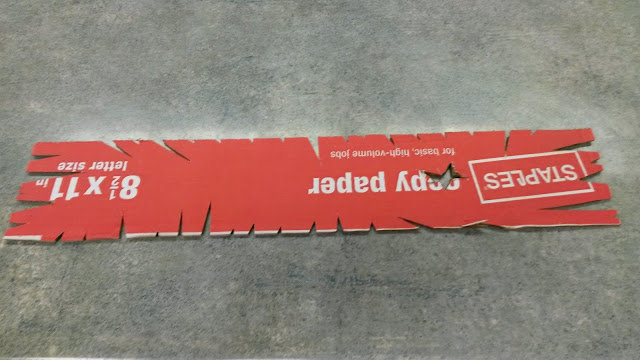$6 - $10 (based on 2015 prices)
Makes twenty boards: ten 24” x 10”, eight 20” x 12”, and two 20” x 10”
Old, weather-worn boards are a perfect means to achieve that abandoned-house look. They can be used to cover doors and windows or erect barriers to direct traffic. Using cardboard to create these props has several advantages, namely the low cost. In fact, since they’re cheap and easy to make, it’s not too disheartening if they’re damaged or stolen. Plus, the colors and degrees of distress can always be adjusted to fit your haunt.
- One 24” x 20” x 30” cardboard box
- One 10 oz. can of interior/exterior, fast-drying spray paint in flat tan
- One 2 oz. bottle of acrylic paint in flat black
- One 2 oz. bottle of acrylic paint in flat brown
- One roll of cheap paper towels
2. In a well-ventilated area, lay the boards out and, holding the spray paint can roughly twelve inches away, spray them with an even coat of paint. Although I only used one coat, you may want more depending on your desired coverage. Keep in mind, though, that this is the base coat and much of the tan paint will be covered up by the darker colors.
3. Once the spray paint has dried, apply several globs of the black and brown acrylic paint to the board and, using a paper towel, smudge the paint across its surface. Don’t be discouraged if it takes you several attempts to achieve a realistic look. You may have to waste a few boards playing with your technique. For me, three methods produced the best results: smearing the paint in the same direction creates a uniform grain; adding additional paint to certain areas and gently smudging it makes nice discolorations; and applying small amounts of paint allows more of the tan color to show, giving the wood a lighter hue.
4. After you have mastered your technique, the process is rather enjoyable and you can add additional elements to give the boards further detail. Use a stipple sponge to fashion knots or a fine-tipped brush to construct worm holes.
5. Because the boards are made from lightweight cardboard, they are easy to hang with clear packaging tape. If you plan to display them outside, you may want to use duct tape to provide a stronger hold against the wind and other elements.
























